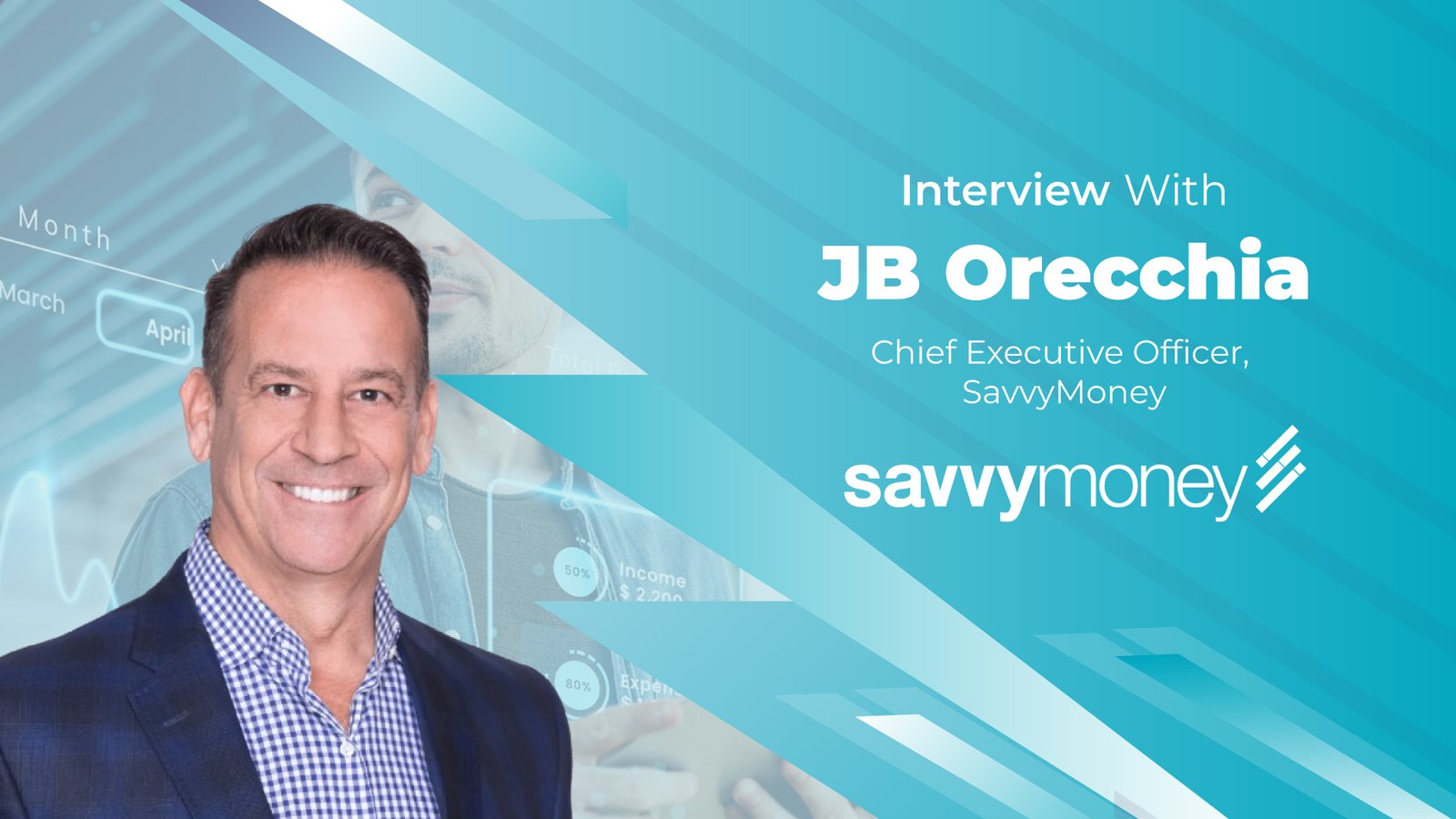A closer look at how integrated education and personalization are transforming customer loyalty in finance.
JB, your leadership at SavvyMoney has consistently blended technology with purpose. What initially drew you to the intersection of financial literacy and digital engagement?
Early in my career, I realized that people’s financial well-being was often limited not by their earnings but by their lack of understanding. When I was a branch manager at Household and later worked with FreeCreditScore/Experian, I realized that technology could make complex financial information accessible and actionable for everyone. At SavvyMoney, that intersection became our mission: using digital tools not just to present data, but to empower users to make smarter financial decisions that ultimately save them money. It’s about taking something that feels intimidating, like credit scores or loans and turning it into a resource people can engage with confidently.
There’s been a shift from just serving younger users to truly understanding their financial stress. How does SavvyMoney frame the difference between being underserved and feeling overwhelmed?
Being underserved means not having access to the right financial products, tools or information in the first place. Feeling overwhelmed, on the other hand, is having those resources at your fingertips but no clear roadmap for how to start, or how your decisions today will shape your long-term financial health. At SavvyMoney, we address both. Our platform now works with over 1,500 financial institution partners to expand access. We pair that with personalized insights, real-time monitoring, and clear guidance — What you measure, you will manage. Helping both our partners and their customers understand their financial path and how to reach their goals.
Many fintech solutions rely heavily on automation, yet you’ve emphasized education as the differentiator. Why is knowledge still such a powerful tool in today’s digital-first financial landscape?
Automation can make processes faster, but it can’t teach judgment or context. Knowledge helps users understand the “why” behind every decision. For example, two users might both make on-time payments, but one understands how credit utilization affects their score while the other doesn’t. Education turns passive engagement into active decision-making, which ultimately drives better financial outcomes. In a digital-first landscape, tools that teach while they transact create a more loyal and informed user base.
The results at Liberty Bank are striking — a 349-point credit score improvement is no small feat. What factors do you credit for this kind of transformative user progress?
The real driver of change isn’t just the tools themselves, but how users engage with them. At Liberty Bank, we focused on making credit education immediate, interactive and relevant to everyday decisions. Younger users could see the impact of their choices in real time, which built confidence and encouraged consistent positive habits. Over 12 months, we saw 52% of Gen Z and Millennial users become “Credit Savvy,” and those starting with the lowest scores saw the most dramatic improvements (a 349-point increase average). These numbers reflect a larger story: when education is accessible, personalized and gamified, it empowers behavior change and builds lasting financial health. As you improve your score, the rates you pay for credit go down, having a real impact that will ultimately lead to building wealth over time.
With the acquisition of CreditSnap, SavvyMoney is evolving into a more integrated platform. What kind of impact does this unified experience have on both users and partner institutions?
The acquisition of CreditSnap is all about making financial wellness tools more seamless, flexible and effective for both banks and their customers. Financial institutions want to grow while minimizing operational complexity and CreditSnap’s technology allows them to do exactly that. Integrating easily with existing systems, streamlining onboarding and reducing application friction. By combining SavvyMoney’s demand-generation capabilities with CreditSnap’s flexible integrations, our partners can now offer an end-to-end digital experience that feels effortless for users.
For customers, this translates into faster, more personalized experiences: loan applications that can drop from 12 minutes to as little as 2, smoother access to credit insights and a platform that actively supports smarter financial decisions. For financial institutions, it drives measurable results. Early adopters have reported loan volume increases of 20–40% and deposit funding rates up to 78%. The larger lesson is clear: when technology is designed to remove friction rather than add complexity, everyone benefits. Financial institutions can grow more efficiently and consumers gain access to the tools and insights they need to improve their financial health.
Financial literacy has traditionally been treated as a static resource. How does SavvyMoney make it dynamic and embedded into everyday financial decision-making?
Instead of a one-time tutorial or generic advice, we embed learning into daily interactions. Every transaction, every payment, every credit inquiry becomes an opportunity to offer context and guidance. Users see in real time how actions affect credit scores, interest rates or loan eligibility. It’s about making education feel relevant, so knowledge isn’t something you read once and forget. It’s something that informs decisions every day. In addition, we deliver relevant content based on behavior in the user experience. As an example, if a users utilization is high, we surface articles that go into detail about how utilization is calculated and can be better managed.
BNPL services are widely used by younger consumers, often without a clear understanding of their implications. How does your platform guide users toward smarter usage of such tools?
BNPL options are becoming increasingly popular, especially with younger consumers, but they can unintentionally lead to overspending if not managed carefully. Many users think of BNPL as free money, but it can affect their ability to pay other bills and impact their debt-to-income ratio. Our platform provides transparency around recommended debt-to-income ratios and expense benchmarks by category. In addition, providing repayment schedules, interest implications and highlighting the cost of credit over time. By surfacing this information at the point of transaction, along with budgeting tools, reminders and educational tips, we empower users to make informed decisions. When young consumers can see the real impact of their choices and plan accordingly, BNPL usage becomes a thoughtful part of their financial strategy rather than an accidental trap.
Matching users with the right financial products at the right time is a nuanced task. What role does personalization play in that matchmaking process?
Personalization is everything. It’s not just about recommending a product; it’s about recommending the right product for that individual at that precise moment. Our data-driven approach takes into account credit behavior, financial goals and even user comfort with risk. A personalized recommendation is meaningful when it aligns with the user’s life stage, habits and needs — otherwise it’s just a loan offer without any context.
For financial institutions that want to build long-term loyalty with Gen Z, what shifts in mindset or strategy do you believe are most urgent?
Institutions need to think beyond transactions. Gen Z values transparency, education and tools that help them make informed choices. That means investing in platforms that educate and engage, not just in products that sell. It also requires understanding behavior at a granular level, like tracking usage patterns, identifying stress points and designing experiences that empower rather than overwhelm. The most successful institutions will treat financial wellness as part of their service, not an afterthought.
Looking ahead, how do you see the relationship between financial wellness and customer engagement evolving in the next 3–5 years?
I see the two becoming inseparable. Engagement will no longer be measured just by clicks or logins; it will be measured by outcomes — how well customers manage credit, save and invest. Tools that combine real-time insights, education and action will define loyalty. Financial institutions that embrace this approach will cultivate advocates who view their bank or platform as a true partner in long-term financial health.

JB Orecchia
Chief Executive Officer, SavvyMoney
JB Orecchia is the President and CEO of SavvyMoney. Since 2011, JB and his team have built SavvyMoney into an industry-leading credit and lending tool that today integrates with 40 digital banking platforms and supports 1,260 financial institutions with their goal of providing financial education and personalized lending. JB has more than 35 years of experience in consumer finance, fintech and interactive media. He started his finance career in 1988 with 10 years in various senior roles at Household International in lending and marketing. In 1998, he saw an opportunity to make credit reports accessible over the internet and joined the original senior team at FreeCreditReport.com/Experian Consumer Direct. As EVP of Partnership Marketing, he led the team responsible for business development and online marketing of the direct-to-consumer credit report and score product for 10 years. To expand on his digital marketing experience post-Experian and pre-SavvyMoney, JB had the opportunity to be Vice President of Marketing for Disney Online, where he directed online marketing, CRM, research and analytics initiatives.

